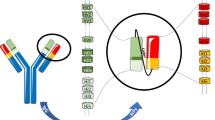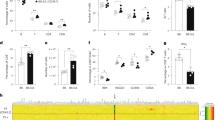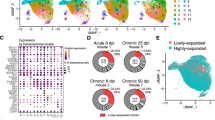Abstract
The BALB/c inbred mouse is widely used in models of infectious disease, transplantation, and cancer. The differences in the immune responses of BALB/c compared to C57BL/6 mice are especially valuable for the identification of immune regulation genes. One striking immune variance between these mice is in the function of natural killer (NK) cells, and there is strong evidence implicating differential expression of Ly49 genes. In this study, the complete BALB/c Ly49 gene cluster has been sequenced and found to contain six functional genes and two pseudogenes. Compared to C57BL/6 mice, there is a 200 kb region absent in the BALB/c cluster including a complete lack of Ly49h-related genes, which explains the increased susceptibility of BALB/c to cytomegalovirus infection. In addition, there is no BALB/c Ly49d allele, explaining the inability of BALB/c NK cells to kill certain tumor cells. The Ly49 region has now been sequenced in three different inbred mouse strains, and comparisons indicate that the evolution of each haplotype is not straightforward and has involved large-scale deletions/insertions, gene recombination, and unequal crossing over between divergent haplotypes. This study confirms that relatively small murine class I MHC receptor haplotypes exist, analogous to observations made of human killer cell Ig-like receptor gene haplotypes.
This is a preview of subscription content, access via your institution
Access options
Subscribe to this journal
Receive 6 digital issues and online access to articles
$119.00 per year
only $19.83 per issue
Buy this article
- Purchase on Springer Link
- Instant access to full article PDF
Prices may be subject to local taxes which are calculated during checkout






Similar content being viewed by others
Accession codes
Abbreviations
- 129S6:
-
129S6/SvEvTac
- B6:
-
C57BL/6
- NK:
-
natural killer
- KIR:
-
killer cell Ig-like receptor
- PIP:
-
percent identity plot
- ALAK:
-
adherent lymphokine-activated killer
- RFLP:
-
restriction fragment length polymorphism
References
Chan PY, Takei F . Molecular cloning and characterization of a novel murine T-cell surface antigen, YE1/48. J Immunol 1989; 142: 1727–1736.
Yokoyama WM, Jacobs LB, Kanagawa O, Shevach EM, Cohen DI . A murine T lymphocyte antigen belongs to a supergene family of type II integral membrane proteins. J Immunol 1989; 143: 1379–1386.
Ortaldo JR, Mason AT, Winkler-Pickett R, Raziuddin A, Murphy WJ, Mason LH . Ly-49 receptor expression and functional analysis in multiple mouse strains. J Leukoc Biol 1999; 66: 512–520.
Koo GC, Peppard JR . Establishment of monoclonal anti-Nk-1.1 antibody. Hybridoma 1984; 3: 301–303.
Daniels KA, Devora G, Lai WC, O’Donnell CL, Bennett M, Welsh RM . Murine cytomegalovirus is regulated by a discrete subset of natural killer cells reactive with monoclonal antibody to Ly49H. J Exp Med 2001; 194: 29–44.
Held W, Roland J, Raulet DH . Allelic exclusion of Ly49-family genes encoding class I MHC-specific receptors on NK cells. Nature 1995; 376: 355–358.
Stoneman ER, Bennett M, An J et al. Cloning and characterization of 5E6(Ly-49C), a receptor molecule expressed on a subset of murine natural killer cells. J Exp Med 1995; 182: 305–313.
Silver ET, Gong DE, Hazes B, Kane KP . Ly-49W, an activating receptor of nonobese diabetic mice with close homology to the inhibitory receptor Ly-49G, recognizes H-2Dk and H-2Dd. J Immunol 2001; 166: 2333–2341.
Makrigiannis AP, Etzler J, Winkler-Pickett R, Mason A, Ortaldo JR, Anderson SK . Identification of the Ly49L protein: evidence for activating counterparts to inhibitory Ly49 proteins. J Leukoc Biol 2000; 68: 765–771.
Mehta IK, Wang J, Roland J, Margulies DH, Yokoyama WM . Ly49A allelic variation and MHC class I specificity. Immunogenetics 2001; 53: 572–583.
Hanke T, Takizawa H, McMahon CW et al. Direct assessment of MHC class I binding by seven Ly49 inhibitory NK cell receptors. Immunity 1999; 11: 67–77.
Silver ET, Lavender KJ, Gong DE, Hazes B, Kane KP . Allelic variation in the ectodomain of the inhibitory Ly-49G2 receptor alters its specificity for allogeneic and xenogeneic ligands. J Immunol 2002; 169: 4752–4760.
Makrigiannis AP, Rousselle E, Anderson SK . Independent control of Ly49g alleles: implications for NK cell repertoire selection and tumor cell killing. J Immunol 2004; 172: 1414–1425.
Proteau M-F, Rousselle E, Makrigiannis AP . Mapping of the BALB/c Ly49 cluster defines a minimal natural killer cell receptor gene repertoire. Genomics 2004; 84: 669–677.
Schwartz S, Zhang Z, Frazer KA et al. PipMaker—a web server for aligning two genomic DNA sequences. Genome Res 2000; 10: 577–586.
Makrigiannis AP, Patel D, Goulet ML, Dewar K, Anderson SK . Direct sequence comparison of two divergent class I MHC natural killer cell receptor haplotypes. Genes Immun 2005; 6: 71–83.
Waterston RH, Lindblad-Toh K, Birney E et al. Initial sequencing and comparative analysis of the mouse genome. Nature 2002; 420: 520–562.
McVicar DW, Taylor LS, Gosselin P et al. DAP12-mediated signal transduction in natural killer cells. A dominant role for the Syk protein-tyrosine kinase. J Biol Chem 1998; 273: 32934–32942.
Brennan J, Lemieux S, Freeman JD, Mager DL, Takei F . Heterogeneity among Ly-49C natural killer (NK) cells: characterization of highly related receptors with differing functions and expression patterns. J Exp Med 1996; 184: 2085–2090.
Wilhelm BT, Gagnier L, Mager DL . Sequence analysis of the Ly49 cluster in C57BL/6 mice: a rapidly evolving multigene family in the immune system. Genomics 2002; 80: 646–661.
Saleh A, Makrigiannis AP, Hodge DL, Anderson SK . Identification of a novel Ly49 promoter that is active in bone marrow and fetal thymus. J Immunol 2002; 168: 5163–5169.
Wilhelm BT, McQueen KL, Freeman JD, Takei F, Mager DL . Comparative analysis of the promoter regions and transcriptional start sites of mouse Ly49 genes. Immunogenetics 2001; 53: 215–224.
Saleh A, Davies GE, Pascal V et al. Identification of probabilistic transcriptional switches in the Ly49 gene cluster: a eukaryotic mechanism for selective gene activation. Immunity 2004; 21: 55–66.
Kubota A, Kubota S, Lohwasser S, Mager DL, Takei F . Diversity of NK cell receptor repertoire in adult and neonatal mice. J Immunol 1999; 163: 212–216.
Nakamura MC, Naper C, Niemi EC et al. Natural killing of xenogeneic cells mediated by the mouse Ly-49D receptor. J Immunol 1999; 163: 4694–4700.
Lee SH, Zafer A, de Repentigny Y et al. Transgenic expression of the activating natural killer receptor Ly49H confers resistance to cytomegalovirus in genetically susceptible mice. J Exp Med 2003; 197: 515–526.
Scalzo AA, Fitzgerald NA, Simmons A, La Vista AB, Shellam GR . Cmv-1, a genetic locus that controls murine cytomegalovirus replication in the spleen. J Exp Med 1990; 171: 1469–1483.
Furukawa H, Iizuka K, Poursine-Laurent J, Shastri N, Yokoyama WM . A ligand for the murine NK activation receptor Ly-49D: activation of tolerized NK cells from beta 2-microglobulin-deficient mice. J Immunol 2002; 169: 126–136.
Nakamura MC, Linnemeyer PA, Niemi EC et al. Mouse Ly-49D recognizes H-2Dd and activates natural killer cell cytotoxicity. J Exp Med 1999; 189: 493–500.
Raziuddin A, Longo DL, Mason L, Ortaldo JR, Bennett M, Murphy WJ . Differential effects of the rejection of bone marrow allografts by the depletion of activating vs inhibiting Ly-49 natural killer cell subsets. J Immunol 1998; 160: 87–94.
Arase H, Mocarski ES, Campbell AE, Hill AB, Lanier LL . Direct recognition of cytomegalovirus by activating and inhibitory NK cell receptors. Science 2002; 296: 1323–1326.
Smith HR, Heusel JW, Mehta IK et al. Recognition of a virus-encoded ligand by a natural killer cell activation receptor. Proc Natl Acad Sci USA 2002; 99: 8826–8831.
Krug A, French AR, Barchet W et al. TLR9-dependent recognition of MCMV by IPC and DC generates coordinated cytokine responses that activate antiviral NK cell function. Immunity 2004; 21: 107–119.
Wilhelm BT, Mager DL . Rapid expansion of the Ly49 gene cluster in rat. Genomics 2004; 84: 218–221.
Hao L, Nei M . Genomic organization and evolutionary analysis of Ly49 genes encoding the rodent natural killer cell receptors: rapid evolution by repeated gene duplication. Immunogenetics 2004; 56: 343–354.
Nylenna O, Naper C, Vaage JT et al. The genes and gene organization of the Ly49 region of the rat natural killer cell gene complex. Eur J Immunol 2005; 35: 261–272.
Wilson MJ, Torkar M, Haude A et al. Plasticity in the organization and sequences of human KIR/ILT gene families. Proc Natl Acad Sci USA 2000; 97: 4778–4783.
Carrington M, Norman P . The KIR Gene Cluster. National Library of Medicine (US), NCBI: Bethesda, MD, 2003.
Lander ES, Linton LM, Birren B et al. Initial sequencing and analysis of the human genome. Nature 2001; 409: 860–921.
Gordon D, Abajian C, Green P . Consed: a graphical tool for sequence finishing. Genome Res 1998; 8: 195–202.
Sonnhammer EL, Durbin R . A dot-matrix program with dynamic threshold control suited for genomic DNA and protein sequence analysis. Gene 1995; 167: GC1–GC10.
Thompson JD, Gibson TJ, Plewniak F, Jeanmougin F, Higgins DG . The CLUSTAL_X windows interface: flexible strategies for multiple sequence alignment aided by quality analysis tools. Nucleic Acids Res 1997; 25: 4876–4882.
Felsenstein J . PHYLIP (Phylogeny Inference Package) version 3.5c. Department of Genetics, University of Washington, Seattle, 1993 (distributed by the author).
Acknowledgements
We gratefully acknowledge Vince Forgetta, Jessica Wasserscheid, Kevin McKee, and Xiaolan Zhang for sequencing and bioinformatics support. This project has been funded in part with Federal funds from the National Cancer Institute, National Institutes of Health, under Contract No. NO1CO12400. This work was also supported in part by an operating grant from the Canadian Institutes for Health Research. APM is a scholar of the Canadian Institutes for Health Research (New Investigator Award).
Author information
Authors and Affiliations
Corresponding author
Additional information
Animal care was provided in accordance with the procedures outlined in ‘A Guide for the Care and Use of Laboratory Animals’ (National Institutes of Health Publication No. 86-23, 1985). The content of this publication does not necessarily reflect the views or policies of the Department of Health and Human Services, nor does mention of trade names, commercial products, or organizations imply endorsement by the US Government.
Rights and permissions
About this article
Cite this article
Anderson, S., Dewar, K., Goulet, ML. et al. Complete elucidation of a minimal class I MHC natural killer cell receptor haplotype. Genes Immun 6, 481–492 (2005). https://doi.org/10.1038/sj.gene.6364232
Received:
Revised:
Accepted:
Published:
Issue Date:
DOI: https://doi.org/10.1038/sj.gene.6364232
Keywords
This article is cited by
-
Analysis of Ly49 gene transcripts in mature NK cells supports a role for the Pro1 element in gene activation, not gene expression
Genes & Immunity (2016)
-
The activating Ly49W and inhibitory Ly49G NK cell receptors display similar affinities for identical MHC class I ligands
Immunogenetics (2014)
-
Structural variation of the mouse natural killer gene complex
Genes & Immunity (2010)
-
Ly49 cluster sequence analysis in a mouse model of diabetes: an expanded repertoire of activating receptors in the NOD genome
Genes & Immunity (2008)
-
The interplay between host and viral factors in shaping the outcome of cytomegalovirus infection
Immunology & Cell Biology (2007)



